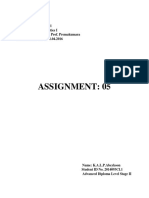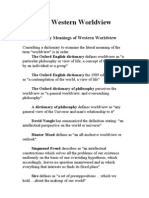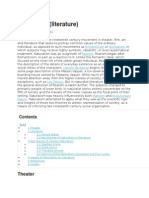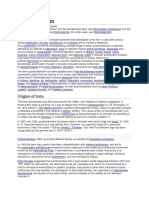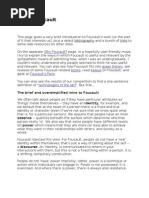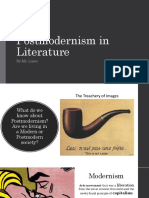Postmodernism
Postmodernism
Uploaded by
sanamachasCopyright:
Available Formats
Postmodernism
Postmodernism
Uploaded by
sanamachasOriginal Description:
Original Title
Copyright
Available Formats
Share this document
Did you find this document useful?
Is this content inappropriate?
Copyright:
Available Formats
Postmodernism
Postmodernism
Uploaded by
sanamachasCopyright:
Available Formats
Postmodernism From Wikipedia, the free encyclopedia Postmodernism literally means 'after the modernist movement'.
While "modern" itself refers to something "related to the present", the movement of mnism and the following reaction of postmodernism are defined by a set of perspectives. It is used in critical theory to refer to a point of departure for works of literature, drama, architecture, cinema, journalism and design, as well as in marketing and business and in the interpretation of history, law, culture and religion in the late 20th and early 21st centuries. Postmodernism is an aesthetic, literary, political or social philosophy, which was the basis of the attempt to describe a condition, or a state of being, or something concerned with changes to institutions and conditions (as in Giddens, 1990) as postmodernity. In other words, postmodernism is the "cultural and intellectual phenomenon", especially since the 1920s' new movements in the arts, while postmodernity focuses on social and political outworkings and innovations globally, especially since the 1960s in the West. The Compact Oxford English Dictionary refers to postmodernism as "a style and concept in the arts characterized by distrust of theories and ideologies and by the drawing of attention to conventions." [1] The term postmodern is described by Merriam-Webster as meaning either "of, relating to, or being an era after a modern one" or "of, relating to, or being any of various movements in reaction to modernism that are typically characterized by a return to traditional materials and forms (as in architecture) or by ironic self-reference and absurdity (as in literature)", or finally "of, relating to, or being a theory that involves a radical reappraisal of modern assumptions about culture, identity, history, or language". [2] The American Heritage Dictionary describes the meaning of the same term as "Of or relating to art, architecture, or literature that reacts against earlier modernist principles, as by reintroducing traditional or classical elements of style or by carrying modernist styles or practices to extremes: It [a roadhouse] is so architecturally interesting with its postmodern wooden booths and sculptural clock.[3] Reaction to modernism Postmodernism was originally a reaction to modernism. Largely influenced by the Western European disillusionment induced by World War II, postmodernism refers to a cultural, intellectual, or artistic state lacking a clear central hierarchy or organizing principle and embodying extreme complexity, contradiction, ambiguity, diversity, interconnectedness or interreferentiality,[4] in a way that is often indistinguishable from a parody of itself. It has given rise to charges of fraudulence.[5] Postmodernity is a derivative referring to non-art aspects of history that were influenced by the new movement, namely developments in society, economy and culture since the 1960s. [6] When the idea of a reaction or rejection of modernism was borrowed by other fields, it became synonymous in some contexts with postmodernity. The term is closely linked with poststructuralism (cf. Michel Foucault) and with modernism, in terms of a rejection of its perceived bourgeois, elitist culture.[7] History of the term The term was first used around the 1870s in various areas. For example, John Watkins Chapman avowed "a postmodern style of painting" to get beyond French Impressionism[8] Then, J.M.Thompson, in his 1914 article in The Hibbert Journal (a quarterly philosophical review), used it to describe changes in attitudes and beliefs in the critique of religion: "The raison d'etre of Post-Modernism is to escape from the double-mindedness of Modernism by being thorough in its criticism by extending it to religion as well as theology, to Catholic feeling as well as to Catholic tradition" ('Post-Modernism, J.M.Thompson, The Hibbert Journal Vol XII No.4 July 1914 p. 733).
In 1917 Rudolf Pannwitz used the term to describe a philosophically oriented culture. Pannwitz's idea of postmodernism came from Nietzsche's analysis of modernity and its ends of decadence and nihilism. Overcoming the modern human would be the post-human. But, contrary to Nietzsche, Pannwitz also includes nationalist and mythical elements.[9] It was used later in 1926 by B.I.Bell in his "Postmodernism & other Ess." In 1925 and 1921 it had been used to describe new forms of art and music. In 1942 H. R. Hays used it for a new literary form but as a general theory of an historical movement it was first used in 1939 by the historian Arnold J. Toynbee: "Our own Post-Modern Age has been inaugurated by the general war of 1914-1918." [10] In 1949 it was used to describe a dissatisfaction with modern architecture, leading to the postmodern architecture movement.[11] Postmodernism in architecture is marked by the re-emergence of surface ornament, reference to surrounding buildings in urban architecture, historical reference in decorative forms, and non-orthogonal angles. It may be a response to the modernist architectural movement known as the International Style. The term was applied to a whole host of movements, many in art, music, and literature, that reacted against modernism, and are typically marked by revival of traditional elements and techniques. [12] Walter Truett Anderson identifies postmodernism as one of four world views. These four worldviews are the postmodern-ironist, which sees truth as socially constructed, the scientific-rational in which truth is found through methodical, disciplined inquiry, the social-traditional in which truth is found in the heritage of American and Western civilisation and the neoromantic in which truth is found either through attaining harmony with nature and/or spiritual exploration of the inner self.[13] Influence and distinction from postmodernity Postmodernist ideas in philosophy and the analysis of culture and society expanded the importance of critical theory and has been the point of departure for works of literature, architecture, and design, as well as being visible in marketing/business and the interpretation of history, law and culture, starting in the late 20th century. These developments re-evaluation of the entire Western value system (love, marriage, popular culture, shift from industrial to service economy) that took place since 1950's and 1960s, with a peak in the Social Revolution of 1968 are described with the term postmodernity,[14] as opposed to postmodernism, a term referring to an opinion or movement. Whereas something being "postmodernist" would make it part of the movement, its being "postmodern" would place it in the period of time since the 1950s, making it a part of contemporary history. The usage and extent of the concept of postmodernism Whether postmodernism is seen as a critical concept or merely a buzzword, one cannot deny its range. Dick Hebdige, in his Hiding in the Light illustrates this: When it becomes possible for a people to describe as postmodern the dcor of a room, the design of a building, the diegesis of a film, the construction of a record, or a scratch video, a television commercial, or an arts documentary, or the intertextual relations between them, the layout of a page in a fashion magazine or critical journal, an antiteleological tendency within epistemology, the attack on the metaphysics of presence, a general attenuation of feeling, the collective chagrin and morbid projections of a post-War generation of baby boomers confronting disillusioned middle-age, the predicament of reflexivity, a group of rhetorical tropes, a proliferation of surfaces, a new phase in commodity fetishism, a fascination for images, codes and styles, a process of cultural, political or existential fragmentation and/or crisis, the de-centring of the subject, an incredulity towards metanarratives, the replacement of unitary power axes by a plurality of power/discourse formations, the implosion of meaning, the collapse of cultural hierarchies, the dread engendered by the threat of nuclear self-destruction, the decline of the university, the functioning and effects of the new miniaturised technologies, broad societal and economic shifts into a media, consumer or multinational phase, a sense (depending on who you read) of placelessness or the abandonment of placelessness (critical regionalism) or (even) a generalised substitution of spatial for temporal coordinates - when it becomes possible to describe all these things as postmodern (or more simply using a current abbreviation as post or very post) then its clear we are in the presence of a buzzword. [15]
Development of postmodernism The movement of Postmodernism began with architecture, as a reactionary movement against the perceived blandness and hostility present in the Modern movement. Modern Architecture as established and developed by masters such as Walter Gropius and Philip Johnson was focused on the pursuit of an ideal perfection, harmony of form and function[16] and dismissal of frivolous ornament.[17] Critics of modernism argued that the attributes of perfection and minimalism themselves were subjective, and pointed out anachronisms in modern thought and questioned the benefits of its philosophy.[18] Definitive postmodern architecture such as the work of Michael Graves rejects the notion of a 'pure' form or 'perfect' architectonic detail, instead conspicuously drawing from all methods, materials, forms and colors available to architects. Postmodern architecture began the reaction against the almost totalitarian qualities of Modernist thought, favoring personal preferences and variety over objective, ultimate truths or principles. It is this atmosphere of criticism, skepticism and subjectivity that defines the postmodern philosophy. Notable philosophical and literary contributors This section is missing citations or needs footnotes. Please help add inline citations to guard against copyright violations and factual inaccuracies. (September 2008) Main article: Postmodern literature Certain interpretations of Sren Kierkegaard, Karl Marx, and Friedrich Nietzsche are important precursors to postmodernism. With their emphasis on skepticism, especially concerning objective reality, social morals, and societal norms[19], all three philosophers, for the postmodernists, represent a reaction to modernism ending in Georg Wilhelm Friedrich Hegel. Other notable influences on postmodernism include Laurence Sterne's novel Tristram Shandy, Alfred Jarry's 'Pataphysics, and the work of Lewis Carroll.[citation needed] Art and literature of the early part of the 20th century play a significant part in shaping the character of postmodern culture. Dadaism attacked notions of high art in an attempt to break down the distinctions between high and low culture; Surrealism further developed concepts of Dadaism to celebrate the flow of the subconscious with influential techniques such as automatism and nonsensical juxtapositions (evidence of Surrealism's influence on postmodern thought can be seen in Foucault's and Derrida's references to Rene Magritte's experiments with signification). Some other significant contributions to postmodern culture from literary figures include the following: Jorge Luis Borges experimented in metafiction and magical realism; William S. Burroughs wrote the prototypical postmodern novel Naked Lunch and developed the cut up method (similar to Tristan Tzara's "How to Make a Dadaist Poem") to create other novels such as Nova Express; Samuel Beckett attempted to escape the shadow of James Joyce by focusing on the failure of language and humanity's inability to overcome its condition, themes later to be explored in such works as Waiting for Godot. Postcolonialism after World War II contributed to the idea that one cannot have an objectively superior lifestyle or belief. This idea was taken further by the anti-foundationalist philosophers: Heidegger, then Derrida, who examined the fundamentals of knowledge; they argued that rationality was neither as sure nor as clear as modernists or rationalists assert. It is with the end of the Second World War that recognizably postmodernist attitudes begin to emerge. It is possible to identify the burgeoning anti-establishment movements of the 1960s as the constituting event of postmodernism. The theory gained some of its strongest ground early on in French academia. In 1971, the ArabAmerican theorist Ihab Hassan was one of the first to use the term in its present form (though it had been used by many others before him, Charles Olson for example, to refer to other literary trends) in his book: The Dismemberment of Orpheus: Toward a Postmodern Literature; in it, Hassan traces the development of what he called "literature of silence" through Marquis de Sade, Franz Kafka, Ernest Hemingway, Beckett, and many others, including developments such as the Theatre of the Absurd and the nouveau roman. In 1979 Jean-Franois Lyotard wrote a short but influential work The Postmodern Condition: A report on knowledge. Richard Rorty wrote
Philosophy and the Mirror of Nature (1979). Jean Baudrillard, Michel Foucault, and Roland Barthes are also influential in 1970s postmodern theory. Postmodern music Main articles: Postmodern music and Postmodern classical music The postmodern impulse in classical music arose in the 1970s with the advent of musical minimalism. Composers such as Terry Riley, John Adams, Steve Reich, Phillip Glass, and Lou Harrison reacted to the perceived elitism and dissonant sound of atonal academic modernism by producing music with simple textures and relatively consonant harmonies. Some composers have been openly influenced by popular music and world ethnic musical traditions. Though representing a general return to certain notions of music-making that are often considered to be classical or romantic[citation needed], not all postmodern composers have eschewed the experimentalist or academic tenets of modernism. The works of Dutch composer Louis Andriessen, for example, exhibit experimentalist preoccupation that is decidedly anti-romantic. Eclecticism and freedom of expression, in reaction to the rigidity and aesthetic limitations of modernism, are the hallmarks of the postmodern influence in musical composition. Philosophical movements and contributors
Influencer Karl Barth Martin Heidegger Thomas Samuel Kuhn Jacques Derrida Michel Foucault
Year Influence c.1925 fideist approach to theology brought a rise in subjectivity c.1927 rejected the philosophical grounding of the concepts of "subjectivity" and "objectivity" posited the rapid change of the basis of scientific knowledge to a provisional consensus of scientists, coined the term "paradigm shift" re-examined the fundamentals of writing and its consequences on philosophy in general; c.1967 sought to undermine the language of western metaphysics (deconstruction) examined discursive power in Discipline and Punish, with Bentham's panopticon as his model, and also known for saying "language is oppression" (Meaning that language was c.1975 developed to allow only those who spoke the language not to be oppressed. All other people that don't speak the language would then be oppressed.) c.1962
Jean-Franois c.1979 opposed universality, meta-narratives, and generality Lyotard argues philosophy mistakenly imitates scientific methods; advocates dissolving traditional Richard c.1979 philosophical problems; anti-foundationalism and anti-essentialism Rorty Jean c.1981 Simulacra and Simulation - reality disappears underneath the interchangeability of signs Baudrillard Deconstruction Deconstruction is a term which is used to denote the application of postmodern ideas of criticism, or theory, to a "text" or "artifact", based on architectural deconstructivism. A deconstruction is meant to undermine the frame of reference and assumptions that underpin the text or the artifact. The term "deconstruction" comes from Martin Heidegger, who calls for the destruction or deconstruction (the German "Destruktion" connotes both English words) of the history of ontology. The point, for Heidegger, was to describe Being prior to its being covered over by Plato and subsequent philosophy. Thus, Heidegger himself engaged in "deconstruction" through a critique of post-Socratic thought (which had forgotten the question of Being) and the study of the pre-Socratics (where Being was still an open question).
In later usage, a "deconstruction" is an important textual "occurrence" described and analyzed by many postmodern authors and philosophers. They argue that aspects in the text itself would undermine its own authority or assumptions and that internal contradictions would erase boundaries or categories which the work relied on or asserted. Poststructuralists beginning with Jacques Derrida, who coined the term, argued that the existence of deconstructions implied that there was no intrinsic essence to a text, merely the contrast of difference. This is analogous to the idea that the difference in perception between black and white is the context. A deconstruction is created when the "deeper" substance of text opposes the text's more "superficial" form. This idea is not isolated to poststructuralists but is related to the idea of hermeneutics in literature; intellectuals as early as Plato asserted it and so did modern thinkers such as Leo Strauss. Derrida's argument is that deconstruction proves that texts have multiple meanings and the "violence" between the different meanings of text may be elucidated by close textual analysis. Popularly, close textual analyses describing deconstruction within a text are often themselves called deconstructions. Derrida argued, however, that deconstruction is not a method or a tool but an occurrence within the text itself. Writings about deconstruction are therefore referred to in academic circles as deconstructive readings. Deconstruction is far more important to postmodernism than its seemingly narrow focus on text might imply. According to Derrida, one consequence of deconstruction is that the text may be defined so broadly as to encompass not just written words but the entire spectrum of symbols and phenomena within Western thought. To Derrida, a result of deconstruction is that no Western philosopher has been able to escape successfully from this large web of text and reach that which is "signified", which they imagined to exist "just beyond" the text. The more common use of the term is the more general process of pointing to contradictions between the intent and surface of a work and the assumptions about it. A work then "deconstructs" assumptions when it places them in context. For example, someone who can pass as the opposite sex may be said to "deconstruct" gender identity, because there is a conflict between the superficial appearance and the "reality" of the person's gender. Social construction, structuralism, poststructuralism Often opposed to deconstruction are social constructionists, labeled as such within the analytic tradition, but not usually in the case of the continental tradition. The term was first used in sociologists Peter Berger and Thomas Luckmann's book The Social Construction of Reality. Usually in the continental tradition, the terms structuralism or poststructuralism are used. Maurice Merleau-Ponty is seen as the biggest contributor to structuralism, which is epitomized in the philosophy of Claude Levi-Strauss. Michel Foucault was also a structuralist but then turned to what would be termed poststructuralism, although he himself declined to call his work either poststructuralist or postmodern. Structuralism historically gave way to poststructuralism; often the role of postmodernism within the analytic tradition is played down, although works by major figures of the analytic tradition in the 20th century, including those of Thomas Kuhn and Willard Van Orman Quine, show a similarity with works in the continental tradition for their lack of belief in absolute truth as well as in the pliability of language. In the continental tradition, most works argue that power dissimulates and that society constructs reality, while its individuals remain powerless or almost powerless. Often, both continental and analytic sources argue for a renewed subjectivity, borrowing heavily from Immanuel Kant, while they largely reject his a priori/a posteriori distinction. They both minimize discussions of practical ethics, instead borrowing heavily from post-Holocaust accounts of the need for an ethics of responsibility, which is very rarely practically defined. One of the large differences between analytic postmodern sources and continental postmodern sources is that the analytic tradition by and large guards at least some of the tenets of liberalism, while many continental sources flirt with, or completely immerse themselves in, Marxism. Recently, it is noticeable that some of the ideas found in poststructuralism and postmodernism, as the lack of belief in absolute truth or the idea of a reality constructed, is promoted in a new paradigm within constructivist epistemology.
Criticism Formal, academic critiques of postmodernism can be found in works such as Beyond the Hoax and Fashionable Nonsense. The term postmodernism, when used pejoratively, describes tendencies perceived as relativist, counterenlightenment or antimodern, particularly in relation to critiques of rationalism, universalism or science. It is also sometimes used to describe tendencies in a society that are held to be antithetical to traditional systems of morality. Quotations In 1994, the then-President of the Czech Republic and renowned playwright Vclav Havel gave a hopeful description of the postmodern world as one based on science, and yet paradoxically where everything is possible and almost nothing is certain.[20] Josh McDowell & Bob Hostetler offer the following definition of postmodernism: A worldview characterized by the belief that truth doesnt exist in any objective sense but is created rather than discovered. Truth is created by the specific culture and exists only in that culture. Therefore, any system or statement that tries to communicate truth is a power play, an effort to dominate other cultures.[21] The Italian medievalist and semiotician Umberto Eco characterised "the postmodern attitude as that of a man who loves a very cultivated woman and knows he cannot say to her, I love you madly, because he knows that she knows (and that she knows that he knows) that these words have already been written by Barbara Cartland."[22]
You might also like
- SHAW - Technoculture The Key ConceptsDocument218 pagesSHAW - Technoculture The Key ConceptsGue Martini100% (2)
- Ed Soja ThirdspaceDocument193 pagesEd Soja Thirdspacepoemadelsol69% (13)
- Pages From Harper-Scott - The Event of Music HistoryDocument73 pagesPages From Harper-Scott - The Event of Music HistoryimanidanielleNo ratings yet
- DENZIN The Cinematic Society The Voyeur S Gaze Theory Culture Society 1995Document579 pagesDENZIN The Cinematic Society The Voyeur S Gaze Theory Culture Society 1995Andrea De Almeida RegoNo ratings yet
- Bourdieu 2008 Key Concepts Hysteresis PDFDocument18 pagesBourdieu 2008 Key Concepts Hysteresis PDFapfelbaum11122No ratings yet
- Track 2 Diplomacy ReportDocument18 pagesTrack 2 Diplomacy ReportFernando AquinoNo ratings yet
- Ethics - Internet Encyclopedia of PhilosophyDocument17 pagesEthics - Internet Encyclopedia of PhilosophyPetar ŽivkovićNo ratings yet
- Mikhail Bakhtin From Forms of Time and of The Chronotope in TheDocument1 pageMikhail Bakhtin From Forms of Time and of The Chronotope in ThesanamachasNo ratings yet
- Cultural Studies PDFDocument16 pagesCultural Studies PDFAnjali AntonyNo ratings yet
- Political Philosophy: Frantz Fanon (1925-1961)Document5 pagesPolitical Philosophy: Frantz Fanon (1925-1961)Edno Gonçalves SiqueiraNo ratings yet
- Chaos Theory Math ProjectDocument7 pagesChaos Theory Math ProjectSubhanjan SahaNo ratings yet
- Ethics, Reflexivity, and Ethically Important Moments in Research - Guillemin and GillamDocument21 pagesEthics, Reflexivity, and Ethically Important Moments in Research - Guillemin and GillamJon BarrutiaNo ratings yet
- Assignment: 05Document6 pagesAssignment: 05Lasantha AbeykoonNo ratings yet
- Expressive Pedagogy: Practice/Theory, Theory/PracticeDocument9 pagesExpressive Pedagogy: Practice/Theory, Theory/PracticeMobiNo ratings yet
- Freud Essay QuestionDocument13 pagesFreud Essay Questionapi-315675568No ratings yet
- Bourdieu S Concept of Reflexivity As MetaliteracyDocument15 pagesBourdieu S Concept of Reflexivity As MetaliteracyekiourtiNo ratings yet
- Jacques Derrida: ObjectivesDocument10 pagesJacques Derrida: ObjectivesMarijoy GupaalNo ratings yet
- Hybridity and National Identity in Postcolonial LiteratureDocument5 pagesHybridity and National Identity in Postcolonial LiteratureJoseph KennedyNo ratings yet
- Plato's Republic: PART 7Document11 pagesPlato's Republic: PART 7En100% (1)
- The Pauper's Gift Leela GandhiDocument12 pagesThe Pauper's Gift Leela GandhikalyaanNo ratings yet
- The Origin OF Frankurt School: Calabuga & IdongDocument8 pagesThe Origin OF Frankurt School: Calabuga & IdongHiraiNo ratings yet
- Second Language IdentityDocument4 pagesSecond Language IdentityUrsu TinaNo ratings yet
- Collective MemoryDocument11 pagesCollective MemoryLamiaa HassanNo ratings yet
- Losing Control An Analysis in The Terror in Beauty in The Secret HistoryDocument4 pagesLosing Control An Analysis in The Terror in Beauty in The Secret HistoryAliza ShahzadNo ratings yet
- A Comparative Study of Liberal Humanism and StructuralismDocument1 pageA Comparative Study of Liberal Humanism and StructuralismConsumer LobbyNo ratings yet
- Theory PaperDocument13 pagesTheory PaperEmmanuel InyanzaNo ratings yet
- Topic 4 The Western WorldviewDocument4 pagesTopic 4 The Western WorldviewM Aminuddin AnwarNo ratings yet
- Pedagogies of Strategic Empathy: Navigating Through The Emotional Complexities of Anti-Racism in Higher EducationDocument14 pagesPedagogies of Strategic Empathy: Navigating Through The Emotional Complexities of Anti-Racism in Higher Educationapi-247542954100% (1)
- Towards A Critical Cognitive LinguisticsDocument19 pagesTowards A Critical Cognitive LinguisticsHeba OthmanNo ratings yet
- Dori Laub InterviewDocument14 pagesDori Laub InterviewDaniel Faur100% (1)
- Lit Review Short Working Paper Final FinalDocument28 pagesLit Review Short Working Paper Final FinalJesse Afolabi Ore100% (1)
- Aman of The People AnalysisDocument11 pagesAman of The People Analysisbahi1291% (11)
- GARCIA, Leovino Ricoeur Existential PhenomenologyDocument27 pagesGARCIA, Leovino Ricoeur Existential Phenomenologymendes_breno2535100% (1)
- KHJDZR Falling in Love and LovingDocument246 pagesKHJDZR Falling in Love and LovingqueenistwoodNo ratings yet
- Pierre BourdieuDocument13 pagesPierre BourdieuSudheer KumarNo ratings yet
- History of Humanist PsychologyDocument47 pagesHistory of Humanist PsychologyClaudia BastosNo ratings yet
- Social Bond TheoryDocument17 pagesSocial Bond TheoryYalla SportNo ratings yet
- PostmodernismDocument5 pagesPostmodernismAhmad FauziNo ratings yet
- Lacanion Psychoanalysis PDFDocument12 pagesLacanion Psychoanalysis PDFanaspirantNo ratings yet
- Vol03 No2 3Document36 pagesVol03 No2 3leela4ever100% (1)
- Paradigms of Style - A Study of Zulfikar Ghoses Novels PDFDocument196 pagesParadigms of Style - A Study of Zulfikar Ghoses Novels PDFJeselyn Requioma100% (1)
- Language, Ideology and The World View By: Rana Faqir M. AslamDocument26 pagesLanguage, Ideology and The World View By: Rana Faqir M. AslamRana Aslam100% (2)
- Belk - Possessions and The Extended SelfDocument31 pagesBelk - Possessions and The Extended SelfSharron ShatilNo ratings yet
- Introduction 1 FaircloughDocument8 pagesIntroduction 1 FaircloughKashif MehmoodNo ratings yet
- Gidden's ReflexivityDocument15 pagesGidden's ReflexivitySudheer Kumar0% (1)
- TESIS Walklate The Metamorphosis of The Victim of Crime From Crime To Culture and The Implications For JusticeDocument13 pagesTESIS Walklate The Metamorphosis of The Victim of Crime From Crime To Culture and The Implications For JusticeKaty DiazNo ratings yet
- Foucault and Deleuze IntroductionDocument7 pagesFoucault and Deleuze IntroductionxelamixamNo ratings yet
- Structuralism and Post-StructuralismDocument5 pagesStructuralism and Post-StructuralismMae Ann LinazaNo ratings yet
- Sartre 21 Existentialism Critical ViewsDocument27 pagesSartre 21 Existentialism Critical ViewsMilos Bjelic (M.B. Miljak)100% (1)
- To What Extent Was The NLK A Success JournalDocument23 pagesTo What Extent Was The NLK A Success JournalWill TeeceNo ratings yet
- Naturalism Curent LiterarDocument7 pagesNaturalism Curent LiterarAlina-Alexandra CaprianNo ratings yet
- EXP-3 The Scope of IRDocument2 pagesEXP-3 The Scope of IRMera BukowskiNo ratings yet
- Daniel Gay - Reflexivity and Development Economics - Methodology, Policy and Practice (2009) PDFDocument237 pagesDaniel Gay - Reflexivity and Development Economics - Methodology, Policy and Practice (2009) PDFpuquinaNo ratings yet
- Theory and Approach and ExistentialismDocument6 pagesTheory and Approach and ExistentialismGeleneNo ratings yet
- Binary OppositionDocument1 pageBinary Oppositionsimplenirob75No ratings yet
- Chapter 2Document16 pagesChapter 2js cyberzoneNo ratings yet
- Global Vs CommuneGlobalizers Vs Communitarians: Post-May 1992 Debates Among Thai Public IntellectualsDocument42 pagesGlobal Vs CommuneGlobalizers Vs Communitarians: Post-May 1992 Debates Among Thai Public IntellectualsKasian TejapiraNo ratings yet
- Bakhtin CounterDocument39 pagesBakhtin CounterPaul RobinsonNo ratings yet
- Ethnic Identity DefinitionDocument7 pagesEthnic Identity DefinitionHila LowensteinNo ratings yet
- 4 Is of OppressionDocument3 pages4 Is of OppressionParthShuklaNo ratings yet
- The Implications Of Antonio Rosmini’s Political And Social Philosophy On Fundamental Human RightsFrom EverandThe Implications Of Antonio Rosmini’s Political And Social Philosophy On Fundamental Human RightsNo ratings yet
- Postmodernism: Postmodernism Is A Tendency in Contemporary Culture Characterized by The Problematisation ofDocument8 pagesPostmodernism: Postmodernism Is A Tendency in Contemporary Culture Characterized by The Problematisation ofPramanNo ratings yet
- Postmodernism: The Hibbert JournalDocument9 pagesPostmodernism: The Hibbert JournalGerald DicenNo ratings yet
- Postmodernism: Origins of TermDocument2 pagesPostmodernism: Origins of TermAdeel RazaNo ratings yet
- A Postcolonial PerspectiveDocument8 pagesA Postcolonial PerspectivesanamachasNo ratings yet
- X. Postcolonial & Transnational TheoriesDocument22 pagesX. Postcolonial & Transnational TheoriessanamachasNo ratings yet
- Violent VideosDocument3 pagesViolent VideossanamachasNo ratings yet
- The Contemporary Arabic Novel As Social History: Urban Decadence, Politics and Women in Naguib Mahfouz's FictionDocument4 pagesThe Contemporary Arabic Novel As Social History: Urban Decadence, Politics and Women in Naguib Mahfouz's FictionsanamachasNo ratings yet
- Jayanta MahapatraDocument10 pagesJayanta MahapatrasanamachasNo ratings yet
- Function of PoetryDocument4 pagesFunction of PoetrysanamachasNo ratings yet
- Dr. Arbind Kumar Choudhary Interviews Professor R.K.SinghDocument4 pagesDr. Arbind Kumar Choudhary Interviews Professor R.K.SinghsanamachasNo ratings yet
- Auden Sir No Man's Enemy, SubstanceDocument8 pagesAuden Sir No Man's Enemy, SubstancesanamachasNo ratings yet
- Art of Poetry Paz InterviewDocument28 pagesArt of Poetry Paz InterviewsanamachasNo ratings yet
- War Poetry and SocietyDocument3 pagesWar Poetry and SocietysanamachasNo ratings yet
- Margaret Atwood Notes Towards A PoemDocument5 pagesMargaret Atwood Notes Towards A Poemsanamachas100% (2)
- Julia Grønnevet: Ruins For The FutureDocument3 pagesJulia Grønnevet: Ruins For The FuturesanamachasNo ratings yet
- Robert Hass InterviewDocument9 pagesRobert Hass InterviewsanamachasNo ratings yet
- Orientalism OpinionDocument10 pagesOrientalism OpinionsanamachasNo ratings yet
- Neruda PoetDocument23 pagesNeruda PoetsanamachasNo ratings yet
- Aunt Jennifer's Tigers - The PoemDocument4 pagesAunt Jennifer's Tigers - The PoemsanamachasNo ratings yet
- Study of NovelDocument3 pagesStudy of NovelsanamachasNo ratings yet
- Linda Hutcheon: Navigation SearchDocument26 pagesLinda Hutcheon: Navigation SearchsanamachasNo ratings yet
- Next, Please by Philip LarkinDocument20 pagesNext, Please by Philip LarkinsanamachasNo ratings yet
- What Is PostmodernDocument4 pagesWhat Is PostmodernsanamachasNo ratings yet
- Poetry - Civil WarDocument8 pagesPoetry - Civil WarsanamachasNo ratings yet
- Post Academic ScienceDocument9 pagesPost Academic ScienceBrandon ColeNo ratings yet
- Sahitya AkademiDocument10 pagesSahitya AkademiDaffodilNo ratings yet
- Miller Editorial Journal of Material Culture 1996 Articles 5 14 1Document11 pagesMiller Editorial Journal of Material Culture 1996 Articles 5 14 1CheriChe100% (1)
- ENGL3026 Assessment 1 QuestionsDocument2 pagesENGL3026 Assessment 1 Questionsimane EddarhamiNo ratings yet
- Mario Plenković, Daria MustićDocument7 pagesMario Plenković, Daria MustićYashika BhatiNo ratings yet
- Bardot and Godard in 1963 (Historicizing The Postmodern Image)Document25 pagesBardot and Godard in 1963 (Historicizing The Postmodern Image)Isadora ZilioNo ratings yet
- Capturing The CancanDocument410 pagesCapturing The CancanIsaBel PozziNo ratings yet
- Begc-112 Full BookDocument170 pagesBegc-112 Full BookAth Har JaHanNo ratings yet
- OASE 103 - 11 Towards A Critical RegionalismDocument12 pagesOASE 103 - 11 Towards A Critical RegionalismBatakoja MeriNo ratings yet
- Collaborative Learning CommunitiesDocument6 pagesCollaborative Learning CommunitiesISIplayaNo ratings yet
- History, Discourse and DiscontinuityDocument10 pagesHistory, Discourse and DiscontinuityLuan FerreiraNo ratings yet
- Postmodernism and PoliticsDocument18 pagesPostmodernism and PoliticsPalakNo ratings yet
- Ciocan, Diaconu 2017 Phenomenology of Animality - Studia Phaenomenologica Vol. 17 (2017) ToC PDFDocument8 pagesCiocan, Diaconu 2017 Phenomenology of Animality - Studia Phaenomenologica Vol. 17 (2017) ToC PDFCristian CiocanNo ratings yet
- POSTMODERN Organizational ManagementDocument11 pagesPOSTMODERN Organizational Managementrebecca s. gaddiNo ratings yet
- Creativearts Va Framesoverview Resource s4 s5Document10 pagesCreativearts Va Framesoverview Resource s4 s5lNo ratings yet
- Postmodernism, Modernity, and The Tradition of DissentDocument12 pagesPostmodernism, Modernity, and The Tradition of DissentFretcy VillorenteNo ratings yet
- Nathaniel Lewis-Unsettling The Literary West Authenticity and Authorship-U of Nebraska Press (2003)Document310 pagesNathaniel Lewis-Unsettling The Literary West Authenticity and Authorship-U of Nebraska Press (2003)MCMNo ratings yet
- Thomas Streeter The Net Effect Romanticism Capitalism and The InternetDocument114 pagesThomas Streeter The Net Effect Romanticism Capitalism and The InternetsidissarNo ratings yet
- Colla The Spectre of The PresentDocument13 pagesColla The Spectre of The PresentGuilherme Bianchi100% (1)
- Michel Foucault CourseDocument4 pagesMichel Foucault CourseDhamman MzaliNo ratings yet
- Sheeba Postmodern LiteratureDocument11 pagesSheeba Postmodern LiteratureAmy Brigitte Fuentes TorricoNo ratings yet
- Literatura IIIDocument17 pagesLiteratura IIIOpportunities for SerendipityNo ratings yet
- Between Modernism and Postmodernism-A Comprehensive Study On The Works of Louis I. KahnDocument9 pagesBetween Modernism and Postmodernism-A Comprehensive Study On The Works of Louis I. KahnmooolkaNo ratings yet
- 2013-02 J SandersonDocument52 pages2013-02 J SandersonCss AspirantNo ratings yet
- Red Polemique - Marxism and The Question of IdentityDocument20 pagesRed Polemique - Marxism and The Question of IdentityShishir GuptaNo ratings yet
- Postmodern LiteratureDocument14 pagesPostmodern Literatureapi-376795054100% (1)












